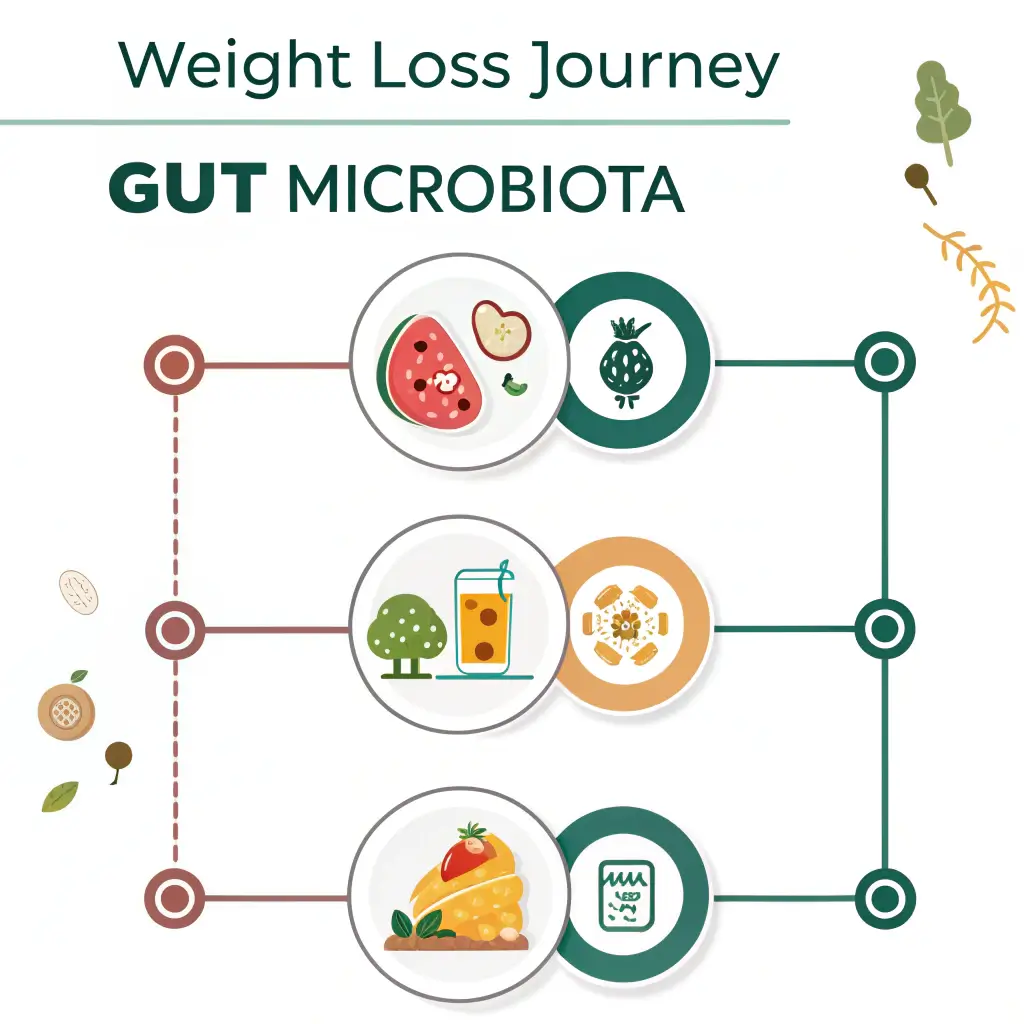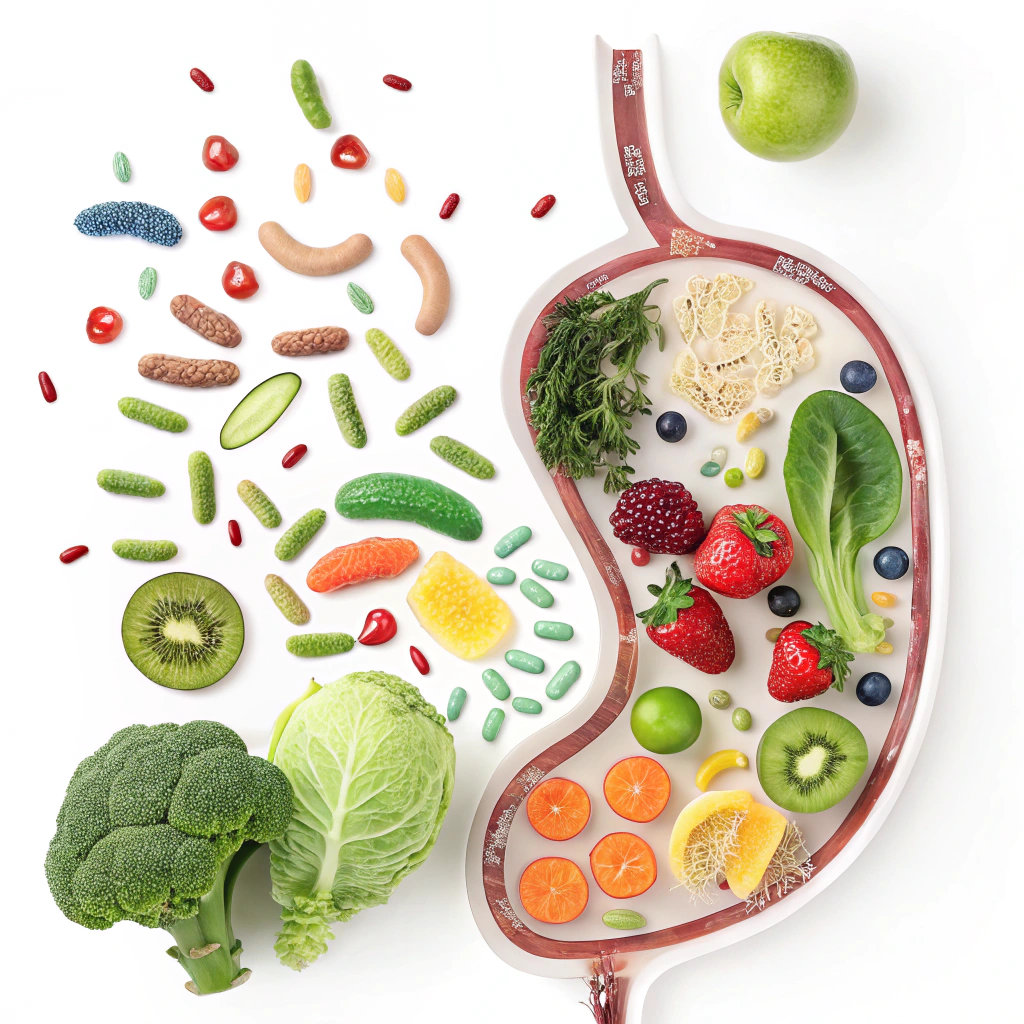Revolutionary research reveals that the 100 trillion bacteria in your gut may hold the key to effortless gut microbiota weight loss – more powerful than any diet you’ve tried. Scientists have discovered that your gut microbiota weight loss potential depends on the delicate balance of microorganisms living in your digestive system, controlling everything from metabolism to appetite regulation.
Despite countless diets and exercise routines, millions struggle with weight loss because they’re ignoring the microscopic ecosystem that controls metabolism, hunger, and fat storage. Traditional approaches focus on calories and willpower, while overlooking the fundamental role that gut bacteria metabolism plays in determining whether your body burns fat or stores it.
Through evidence-based gut microbiota optimization strategies, you can transform your weight loss journey within 8-12 weeks. This comprehensive guide will show you how to harness the power of microbiome weight management for sustainable, long-term results that go far beyond temporary fixes.
Table of Contents
The Science Behind Gut Microbiota and Weight Loss
Understanding how gut microbiota weight loss works requires exploring the fascinating connection between your intestinal bacteria and metabolic processes. Your gut houses over 1,000 different bacterial species, each playing a crucial role in how your body processes food, regulates hunger, and stores energy.
How gut bacteria control metabolism and energy harvesting
Research from the University of Iowa demonstrates that specific gut bacteria strains can influence your metabolic rate study even during rest periods. The bacteria in your digestive system produce enzymes that break down complex carbohydrates, releasing short-chain fatty acids (SCFAs) that directly impact fat storage and energy expenditure.
Beneficial bacteria like Akkermansia muciniphila strengthen your intestinal lining, improving nutrient absorption while reducing inflammation that can slow metabolism. When these helpful microorganisms thrive, they enhance your body’s ability to burn calories efficiently, making gut microbiota weight loss a natural metabolic optimization process.
The gut-brain axis and appetite regulation
Your gut bacteria communicate directly with your brain through the vagus nerve, influencing hunger signals and food cravings. This gut-brain axis explains why gut microbiota weight loss approaches often feel more sustainable than restrictive dieting – you’re working with your body’s natural appetite regulation system rather than against it.
Specific bacterial strains produce neurotransmitters like serotonin and GABA, which affect mood and satiety. When your microbiome is balanced, you naturally experience better appetite control and reduced cravings for processed foods that sabotage weight loss efforts.
Firmicutes vs Bacteroidetes ratio in weight management
The ratio between two major bacterial groups – Firmicutes and Bacteroidetes – significantly impacts weight management. According to Firmicutes-Bacteroidetes ratio findings, individuals with higher Firmicutes populations tend to extract more calories from food, while those with more Bacteroidetes typically maintain healthier weights more easily.
Optimizing this bacterial balance through targeted nutrition and lifestyle changes forms the foundation of effective gut microbiota weight loss strategies. By increasing Bacteroidetes and supporting beneficial Firmicutes strains while reducing harmful varieties, you can naturally shift your metabolism toward fat burning.
Essential Foods That Promote Weight Loss Through Gut Health
Strategic food choices can dramatically improve your gut microbiota weight loss results by feeding beneficial bacteria while starving harmful microorganisms. The key lies in understanding which foods support microbiome diversity and metabolic health.
Prebiotic powerhouse foods for beneficial bacteria growth
Prebiotic foods serve as fuel for beneficial gut bacteria, promoting the growth of species that support healthy weight management. Focus on incorporating these powerful prebiotic sources into your daily meals:
- Jerusalem artichokes – Contains up to 76% inulin by weight, the most potent prebiotic fiber
- Garlic and onions – Rich in fructooligosaccharides that specifically feed Bifidobacterium
- Green bananas – High in resistant starch that increases beneficial bacteria production
- Oats and barley – Contain beta-glucan fiber that supports metabolic health
- Chicory root – Excellent source of inulin for promoting satiety-enhancing bacteria
- Asparagus – Provides prebiotic fibers while supporting liver detoxification
For comprehensive guidance on incorporating these foods effectively, explore our comprehensive prebiotic guide which includes serving recommendations and preparation methods optimized for gut microbiota weight loss.
Fermented foods that directly introduce helpful microorganisms
Fermented foods introduce live beneficial bacteria directly into your digestive system, accelerating gut microbiota weight loss by rapidly improving microbiome diversity. Include these fermented options regularly:
- Greek yogurt (unsweetened) – Contains Lactobacillus and Bifidobacterium strains
- Kefir – Provides over 60 different bacterial strains for maximum diversity
- Kimchi and sauerkraut – Fermented vegetables rich in Lactobacillus
- Miso paste – Adds beneficial bacteria while enhancing umami flavors
- Kombucha (low-sugar varieties) – Delivers probiotics in liquid form
- Tempeh – Fermented legume protein supporting muscle maintenance during weight loss

To maximize the benefits of fermented foods, try our collection of probiotic-rich recipes designed specifically to support gut microbiota weight loss goals while maintaining delicious, satisfying meals.
Anti-inflammatory foods that heal gut lining
Chronic inflammation disrupts gut bacteria balance and slows metabolism. Anti-inflammatory foods repair intestinal damage while creating an environment where beneficial bacteria thrive:
- Fatty fish (salmon, sardines, mackerel) – Omega-3 fatty acids reduce gut inflammation
- Leafy greens – Spinach, kale, and arugula provide anti-inflammatory compounds
- Berries – Blueberries, raspberries contain polyphenols that feed good bacteria
- Turmeric – Curcumin reduces inflammation and supports bacterial diversity
- Ginger – Improves digestion while providing anti-inflammatory benefits
- Green tea – Polyphenols promote beneficial bacteria growth
Consider implementing our anti-inflammatory meal plans to systematically reduce gut inflammation while supporting your gut microbiota weight loss journey.
The Complete Gut Microbiota Weight Loss Protocol
Implementing a structured approach to gut microbiota weight loss ensures consistent progress and measurable results. This 12-week protocol provides a systematic framework for optimizing your microbiome while achieving sustainable weight management.
Week-by-week implementation strategy
Weeks 1-2: Foundation Phase
Begin with gentle microbiome support while eliminating processed foods that harm beneficial bacteria. Introduce one new prebiotic food daily and consume fermented foods twice daily. Focus on establishing consistent meal timing to regulate circadian rhythms that influence gut bacteria activity.
Weeks 3-4: Diversification Phase
Expand your prebiotic variety to include at least 30 different plant foods weekly. This diversity directly correlates with improved gut microbiota weight loss outcomes. Add targeted probiotic supplements and increase fermented food portions.
Weeks 5-8: Optimization Phase
Implement advanced strategies like food combining principles that maximize nutrient absorption. Monitor your body’s response and adjust portions based on hunger cues, which should improve as your gut-brain axis strengthens.
Weeks 9-12: Maintenance Phase
Fine-tune your protocol based on progress markers. By this phase, most people experience significant improvements in gut microbiota weight loss results, with enhanced metabolism, reduced cravings, and sustainable weight management patterns.
Meal timing and intermittent fasting for microbiome optimization
Strategic meal timing amplifies gut microbiota weight loss by allowing beneficial bacteria adequate time to process nutrients and restore gut lining integrity. Consider these evidence-based approaches:
12-hour eating window: Consume all meals within a 12-hour period, allowing 12 hours of digestive rest. This pattern supports natural circadian rhythms that govern bacterial activity cycles.
Time-restricted eating: Gradually narrow your eating window to 8-10 hours if comfortable. Research shows this approach can increase beneficial bacteria diversity while improving metabolic flexibility.
Prebiotic timing: Consume prebiotic-rich foods earlier in the day when digestive fire is strongest, allowing maximum fermentation time for beneficial bacteria to produce weight-supporting metabolites.
Supplement protocols and dosage guidelines
While whole foods form the foundation of gut microbiota weight loss, targeted supplements can accelerate progress and fill nutritional gaps:
- Multi-strain probiotic: 25-50 billion CFUs daily, containing Lactobacillus gasseri and Bifidobacterium lactis for weight management support
- Prebiotic fiber blend: 5-10 grams daily of inulin, FOS, and resistant starch
- Omega-3 fatty acids: 1-2 grams daily EPA/DHA to reduce inflammation
- Digestive enzymes: With meals containing harder-to-digest foods to reduce bacterial overgrowth
- L-glutamine: 5-10 grams daily to support intestinal lining repair
Lifestyle Factors That Accelerate Gut-Based Weight Loss
Beyond nutrition, several lifestyle factors significantly impact gut microbiota weight loss success. Addressing sleep, stress, and exercise creates a comprehensive approach that maximizes your microbiome’s weight management potential.
Sleep optimization for microbiome diversity
Quality sleep directly influences gut bacteria composition and metabolic function. Research from sleep-gut connection research reveals that sleep deprivation reduces beneficial bacteria diversity while increasing inflammation-promoting microorganisms.
Optimize your sleep for gut microbiota weight loss with these strategies:
- Consistent sleep schedule: Go to bed and wake within 30 minutes of the same time daily
- Sleep duration: Aim for 7-9 hours nightly to support bacterial restoration cycles
- Evening routine: Stop eating 3 hours before bed to allow digestive processes to complete
- Sleep environment: Maintain cool, dark conditions that promote deep sleep phases
According to sleep consistency study, maintaining sleep timing within 90 minutes variance significantly improves gut bacteria diversity compared to irregular sleep patterns.
For detailed guidance on improving sleep quality, explore our sleep optimization techniques specifically designed to support gut microbiota weight loss goals.
Stress management techniques for gut-brain health
Chronic stress disrupts the gut-brain axis, promoting harmful bacteria growth while suppressing beneficial microorganisms essential for weight management. Implementing stress reduction strategies is crucial for gut microbiota weight loss success:
- Meditation and mindfulness: 10-20 minutes daily reduces cortisol levels that disrupt gut bacteria
- Deep breathing exercises: Activates the parasympathetic nervous system, improving digestion
- Progressive muscle relaxation: Reduces physical tension that affects digestive function
- Nature exposure: Spending time outdoors increases beneficial bacteria exposure
- Social connections: Positive relationships support healthy stress responses
Consider incorporating stress-reducing recipes that combine gut-supporting nutrients with ingredients known to promote relaxation and emotional well-being.
Exercise types that promote beneficial bacteria growth
Specific exercise modalities enhance gut microbiota weight loss by promoting beneficial bacteria diversity and improving metabolic flexibility:
Moderate aerobic exercise: 30-45 minutes of walking, swimming, or cycling 3-4 times weekly increases bacterial diversity without overstressing the system.
Resistance training: 2-3 sessions weekly support muscle maintenance during weight loss while promoting beneficial bacterial strains associated with improved metabolic health.
High-intensity interval training (HIIT): 1-2 sessions weekly can improve gut bacteria diversity, but excessive high-intensity exercise may increase stress hormones that disrupt microbiome balance.
Yoga and tai chi: These practices combine gentle movement with stress reduction, supporting both gut-brain axis function and bacterial diversity.
Measuring Your Gut Microbiota Weight Loss Progress
Tracking progress in gut microbiota weight loss requires monitoring both traditional weight metrics and microbiome-specific indicators. This comprehensive approach helps you understand how bacterial changes translate into improved health outcomes.
Key biomarkers and symptoms to track
Monitor these indicators to gauge your gut microbiota weight loss progress effectively:
Digestive improvements: Reduced bloating, more regular bowel movements, and decreased digestive discomfort indicate improving bacterial balance.
Energy levels: Increased stable energy throughout the day suggests better bacterial metabolism and nutrient absorption.
Sleep quality: Improved sleep patterns reflect better gut-brain axis function and reduced inflammation.
Mood stability: More consistent mood and reduced anxiety often accompany microbiome improvements.
Cravings reduction: Decreased sugar and processed food cravings indicate healthier bacterial populations influencing appetite signals.
Physical measurements: Track waist circumference, body fat percentage, and muscle mass alongside traditional weight measurements.
Timeline expectations for microbiome changes
Understanding realistic timelines helps maintain motivation during your gut microbiota weight loss journey:

Week 1-2: Initial digestive improvements and reduced bloating as harmful bacteria populations begin decreasing.
Week 3-4: Energy levels stabilize, and sleep quality improves as beneficial bacteria establish stronger populations.
Week 5-8: Noticeable weight loss acceleration, reduced cravings, and improved mood stability as microbiome diversity increases.
Week 9-12: Sustainable weight management patterns emerge with significant improvements in metabolic markers and overall well-being.
Month 4-6: Long-term bacterial changes solidify, creating lasting metabolic improvements that support continued weight management.
When to adjust your protocol for better results
Recognize when modifications can improve your gut microbiota weight loss outcomes:
- Plateau after 4 weeks: Increase prebiotic variety or adjust meal timing windows
- Persistent digestive issues: Reduce fiber intake temporarily and focus on healing foods
- Excessive fatigue: Ensure adequate caloric intake and consider reducing exercise intensity
- Minimal weight changes: Evaluate stress levels, sleep quality, and hidden processed food consumption
- Mood decline: Increase fermented foods and consider professional support for underlying stressors
Frequently Asked Questions About Gut Microbiota Weight Loss
How long does it take to see weight loss results from gut microbiota optimization?
Most people experience initial improvements within 2-4 weeks, including reduced bloating and increased energy. Significant gut microbiota weight loss results typically become apparent at 8-12 weeks, when bacterial populations have had sufficient time to rebalance and influence metabolic processes. Individual timelines vary based on starting microbiome diversity, adherence to the protocol, and lifestyle factors.
Can gut microbiota weight loss work without changing my diet completely?
Yes, incremental changes can still produce meaningful gut microbiota weight loss results. Start by adding one prebiotic food and one fermented food daily while eliminating processed snacks. This minimum effective approach allows gradual bacterial shifts without overwhelming dietary changes. However, more comprehensive modifications typically accelerate and amplify results.
What are the best probiotics for gut microbiota weight loss?
Research supports specific strains for weight management: Lactobacillus gasseri has shown particular promise for reducing abdominal fat, while Bifidobacterium lactis improves metabolic markers. Lactobacillus rhamnosus may help with weight maintenance, and Akkermansia muciniphila supports metabolic health. Choose multi-strain supplements containing these varieties for optimal gut microbiota weight loss support.
Is gut microbiota weight loss safe for people with digestive disorders?
Individuals with diagnosed digestive conditions should consult healthcare providers before implementing intensive gut microbiota weight loss protocols. Those with SIBO, IBD, or severe gut dysbiosis may need modified approaches starting with lower fiber intake and specific therapeutic protocols. Generally, gentle microbiome support through fermented foods and stress reduction is well-tolerated across most conditions.
Individuals with diagnosed digestive conditions should consult healthcare providers before implementing intensive gut microbiota weight loss protocols. Those with SIBO, IBD, or severe gut dysbiosis may need modified approaches starting with lower fiber intake and specific therapeutic protocols. Generally, gentle microbiome support through fermented foods and stress reduction is well-tolerated across most conditions.
Individuals with diagnosed digestive conditions should consult healthcare providers before implementing intensive gut microbiota weight loss protocols. Those with SIBO, IBD, or severe gut dysbiosis may need modified approaches starting with lower fiber intake and specific therapeutic protocols. Generally, gentle microbiome support through fermented foods and stress reduction is well-tolerated across most conditions.
How does gut microbiota weight loss differ from traditional dieting?
Unlike restrictive dieting that often slows metabolism, gut microbiota weight loss works by optimizing your body’s natural metabolic processes. This approach focuses on feeding beneficial bacteria that enhance fat burning rather than restricting calories. Results tend to be more sustainable because you’re improving underlying metabolic function rather than fighting against your body’s natural systems.
Can I combine gut microbiota optimization with other weight loss methods?
Gut microbiota weight loss strategies complement most healthy weight loss approaches excellently. The microbiome support enhances results from balanced nutrition plans, regular exercise, and stress management. Avoid combining with extreme restrictions or rapid weight loss protocols that might disrupt beneficial bacteria. The microbiome approach actually makes other healthy practices more effective by improving metabolic flexibility and appetite regulation.
Transform Your Health Through Gut Microbiota Weight Loss
Gut microbiota weight loss represents a fundamental shift from restrictive dieting to metabolic optimization that works with your body’s natural systems. The comprehensive 12-week protocol outlined provides measurable results when followed consistently, addressing not just weight management but overall health improvement through microbiome diversity.
Successful implementation requires commitment to lifestyle integration that ensures long-term success beyond quick fixes. By supporting beneficial bacteria through strategic nutrition, optimized sleep, stress management, and appropriate exercise, you create sustainable metabolic changes that naturally maintain healthy weight.
Start your gut microbiota weight loss journey today by incorporating just one prebiotic food and one fermented option into your daily routine. These small changes begin the bacterial shifts that can transform your metabolic health and weight management success over the coming months.

